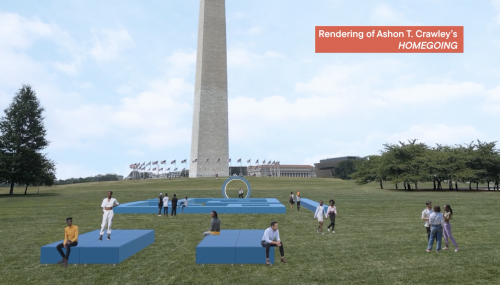Visitors to the National Mall in Washington, DC, have a rare opportunity to check out a series of temporary installations, including Ashon T. Crawley’s Homegoing, an audiovisual AIDS memorial that centers spirituality and the Black queer church musicians lost to the HIV epidemic.
Crawley, an African-American artist, writer and professor based in Richmond, Virginia, is one of six artists who contributed works of art for Beyond Granite: Pulling Together, a pilot exhibition that seeks to answer the question: What stories remain untold on the National Mall?
The National Mall is famous for its permanent larger-than-life monuments, memorials and museums—often made of granite—spread across nearly 700 acres of parks near the U.S. Capitol. Beyond Granite marks the first time that curated, temporary works have been displayed on the Mall, reports The Washington Post.

“Homegoing” is an audiovisual AIDS memorial.YouTube/Trust for the National Mall
The works will be on view until September 18. You can learn more about the project on BeyondGranite.org. The site describes Homegoing as follows:
Ashon T. Crawley’s Homegoing mourns and celebrates those gone too soon from the AIDS crisis, past and present, by channeling Black queer music as a spiritual practice. The artist achieves this, as he notes, “by staging an audiovisual memorial to queer musicians, choir directors and songs from Black church contexts. [These people were] often closeted, the fullness of their stories still untold.” Crawley’s composition consists of three movements—Procession, Sanctuary and Benediction—performed in an open-air shrine. With sightlines to the Washington Monument and the Smithsonian National Museum of African American History and Culture, Homegoing is situated in accordance with the National Mall’s legacy of important sites of mourning and resistance, including the first display of the AIDS Memorial Quilt in 1987 and the ACT UP protests of the late 1980s and early 1990s.
Crawley’s Homegoing is located just south of the Washington Monument. You can listen to the piece here.
“One of the reasons why music is the root of this project,” Crawley explains in a related video on BeyondGranite.org, “is because as a young person who felt very queer but also unsure what that meant, I was afraid to become a musician and a choir director because I had noticed that a lot of them were dying and that there was a lot of rumor and gossip about these musicians. There wasn’t a lot of conversation about their life. There was a lot of castigation. There was a lot of nasty language used to describe them. And I was deeply afraid I was becoming like the very ones who were dying. I’m trying to also use music as a saving ground, for a reckoning with stories that have not been told.”
Here’s a different video about the Beyond Granite project and artists:
The other artists exhibiting their work on the Mall are Derrick Adams, Tiffany Chung, vanessa german, Paul Ramírez Jonasa and Wendy Red Star. Their works explore immigration, Native American treaties that have been ignored or abrogated, desegregation and more.
In related news, over 4,000 HIV advocates, researchers, allies and health care providers are gathering in DC from September 5 to 9 for the annual U.S. Conference on HIV/AIDS. (#USCHA).







Comments
Comments